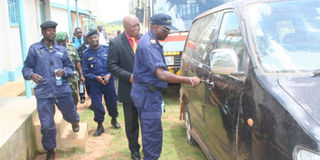Why stolen cars find way into DR Congo

Crackdown. A Congolese police officer hands over one of the recovered vehicles from Bunia, DR Congo, to Ugandan officials at Vurra Customs last year. PHOTO BY CLEMENT ALUMA
West Nile- Despite fitting a tracking system in your car, it might take thieves about two minutes to steal the vehicle.
They are not deterred since many exploit the porous borders across the West Nile sub-region to easily drive away the cars to DR Congo.
Several stolen cars are mainly sneaked through the border areas of Panyimur, Parombo, Goli, Vurra, Padeya, Odramacaku or Koboko to the neighbouring country.
Apart from these gazetted entry/exit points, there are more than 600 illegal routes across the sub-region that the criminals use.
Despite the establishment of a border monitoring unit tasked to ensure that the criminal network is destroyed, cars are still being stolen.
Since the beginning of this year, 67 stolen cars have been recovered.
It was also discovered that Ugandan business community in DR Congo has suffered several setbacks arising from robbery of their merchandise and vehicles by the Congolese.
One can track a stolen car online with a vehicle identification number, an installed security camera and a GPS tracking system.
Recently, a car owner, Mr Cyrus Njoroge, based in Nairobi, Kenya, said his car was stolen in February.
“It is good that I had installed a GPS system that allowed me to keep tracking the whereabouts of the car,” he said.
Mr Njoroge said his car was stolen while parked near a pub in Nairobi.
In the past three weeks, two cars and a Fuso truck were recovered after being stolen from Kampala and Iganga districts.
Last weekend, the Police Flying Squad shot dead two men for allegedly stealing a car.
The duo were shot at Odramacaku, near the DR Congo border.
According to police, the thugs allegedly carry out their mission after offering drivers drinks doused with chloroform, especially in hotels.
Thieves then duplicate the car keys and sell the vehicles to a racket of buyers, who are well established in Uganda and Dr Congo.
Security sources told Daily Monitor that the stolen cars are normally sold in DR Congo between $2,500 (about Shs9 million and $3,000 (Shs10m) depending on the type and model.
In July, the Border Monitoring Unit (BMU) was formed with the Assistant Inspector of Police in charge of Interpol, Mr Fred Yiga, urging police from both countries to tackle the vice.
“Ugandans are hard working and it is disheartening that after struggling for a long time to buy a car, it is stolen and sold in DRC. We need to stop this vice,” Mr Yiga said.
Col Willy Rae of DR Congo police, apologised for the theft, adding that every week, cars with either South Sudan or Congolese number plates enter Arua District through the customs points without being detected.
He promised to start a new approach to tackle the cross-border crimes and called for cooperation between both countries.
The Arua Resident District Commissioner, Mr Peter Debele, said a regional meeting will soon be convened for all the border-lying districts of WestNile to discuss the issue.
“Sometimes our counterparts frustrate us because they ask for money before the cars are released. But we want to always ensure that this crime stops,” Mr Debele said.
Daily Monitor investigations show that there is a racket involving a group of men who are employed by a one Samonga.
He is believed to have allies in Uganda who earn on a commission after successfully delivering the stolen cars to him in DR Congo.
Samonga has been on the police wanted list for about seven years.
How thieves steal cars
A top officer in the Directorate of Crime Intelligence, who takes part in tracking and analysing car thefts, said spotters are vital in the execution of the thefts, but car owners never pay attention to them. The police officer said the spotters usually operate at washing bays and motorcycle stages. He said guards are also involved.
The spotters, the officer said, are paid between Shs30,000 and Shs100,000 per successful car theft. Some spotters have motorcycles which they use to trail the target motorists for some time.Upon reaching the target car, the intelligence officer further revealed that the spotters inform the sponsor, who sends two other people, one to break the car door lock and another to drive it away.
For the old Japanese vehicles, the criminal uses a locally made sharp metallic object, which he enters into the car door lock and exerts force up and down. The thieves have codenamed the metallic object Luso, a Luganda word meaning “master knife”.
Two suspects in car plunder held at the Directorate of Crime Intelligence demonstrated the trick on a Toyota Ipsum and a Toyota Noah vehicles. They applied the Luso and the car door locks opened in seconds. “I am given Shs200,000 for opening the door,” one suspect confessed, but said he does not drive away the stolen car. That role is done by another person.
“The driver gets into the car and uses the same Luso to ignite the car before driving it away to a hideout,” the suspect confessed.
He said the stolen car is taken to a garage where it is kept for days until the police have given up the search.
Police detectives established that the thieves replace the car door and ignition locks, which have been destroyed. According to police, car thieves have adopted the new method of first holding stolen cars in garages because they have learnt that police sends messages to all units whenever a car is stolen, which makes it easy to recover while being driven on the highway.
By Andrew Bagala




